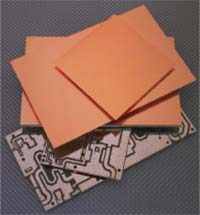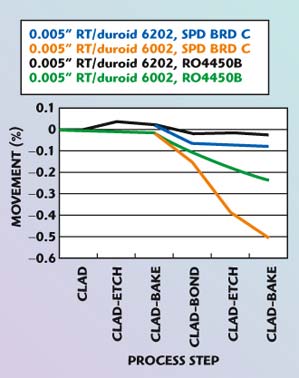 | |||
The introduction of RT/duroid®6002 high frequency circuit material, manufactured by Rogers Corp. in the late 1980s, changed entirely what RF/microwave engineers could select for circuit board materials. Up until that time, designers seeking options of high frequency materials could select laminates with low or high dielectric constant, based on polytetrafluoroethylene (PTFE). However, these materials usually had the disadvantage of having high coefficients of thermal expansion, which usually led to dimensional stability problems and plated through hole (PTH) failures. Another problem encountered with materials based on PTFE was stability of the dielectric constant vs. temperature. The RT/duroid 6002 product changed all that by becoming the first material designed specifically for electrical and mechanical stability against temperature. In addition, this material was the first in the market that allowed designers to build multilayer board (MLB) constructions (not just stripline) and match it with FR4 to create boards that covered the full range of frequencies needed in military and high reliability applications.
Since that time, designer needs have changed. Many applications require materials that not only have excellent electrical and mechanical properties, but also allow PCB fabricators to create complex high frequency MLBs with high yields. To address this market, Rogers has recently improved on RT/duroid 6002 material to create RT/duroid 6202. Like RT/duroid 6002, RT/duroid 6202 has low loss and tightly controlled dielectric constant for the most demanding electrical needs. Similar to RT/duroid 6002, RT/duroid 6202 mechanical properties are such that designers can expect long-term reliability of PTH, a requirement in many military designs. RT/duroid 6202 differs from RT/duroid 6002 in that because of increased mechanical rigidity, dimensional movement through the PCB process is more repeatable in this product, particularly in thin material (< 0.010"). Processes like multilayer bonding exert high stress on the product due to exposure to high temperature and pressure. Material movement predictability allows PCB shops to hold tight dimensional tolerances needed in building complex MLBs.
Products that have traditionally serviced this market were composed of PTFE/ceramic, which yields very low loss materials or were made of PTFE/ceramic/woven glass. This resulted in increased rigidity. The strength of one product was, of course, the weakness of the other. RT/duroid 6202 provides a different solution to designer needs. This was accomplished by reinforcing RT/duroid 6002 with layers of woven glass, giving it greater structural support by keeping the PTFE-to-glass ratio high, while still achieving a very low loss product. Table 1 presents a comparison of key properties of RT/duroid 6202, RT/duroid 6002 and a competitive material in the market.
 | ||
RT/duroid 6202 has a loss tangent of 0.0015 at 10 GHz, significantly lower than other products with similar dielectric constants. Demanding designs looking for improved loss characteristics could do so by selecting RT/duroid 6202 over PTFE/ceramic/woven glass. The measured insertion loss of a 50 Ω line on 0.020" material is presented in Figure 1. It shows that even at 10 GHz, due to the low loss tangent of the material, the expected loss is 0.08 dB/inch.
 | ||
| Fig. 1 RT/duroid 6202 microstrip insertion loss (0.020", 1/2 oz. rolled). | ||
Many applications today require high frequency materials for various layers and at times bonded on FR4 MLBs as well. Any time MLBs are to be built, manufacturability of the design is a concern. When dealing with MLBs, PCB engineers become concerned about bow and twist (especially if FR4 is involved) and dimensional movement effects on positional tolerances. A key factor in reducing bow and twist, even when working on a hybrid design, is that the X/Y plane’s coefficient of thermal (CTE) expansion be as closely matched to copper as possible. Copper foil normally has a CTE of 16; therefore, the desired X/Y plane CTE for the ideal material would also be 16. Like RT/duroid 6002, RT/duroid 6202 is closely matched to copper, allowing the designer the option to build MLBs with minimal bow and twist. In the case of hybrid constructions, FR4 is also closely matched to copper’s CTE. PCB fabricators can then bond hybrid PCBs with RT/duroid 6202. Long-term reliability, particularly PTH reliability, is also a concern of many military program designers. Like its predecessor, RT/duroid 6202 has very low Z-axis expansion at 30 ppm/°C.
Besides bow and twist, dimensional movement is always a concern of the engineer tasked with fabricating the MLB. Movement through the PCB process was studied and the findings are shown in Figure 2. In this case, 0.005" RT/duroid materials were bonded with Gore Speedboard® C and Rogers RO4450B materials. The material was measured throughout inner layer processing to determine which step has the greatest impact on material movement. MLB bonding (lamination) is where most of the movement occurs. RT/duroid 6202 material experienced 20 percent of the movement that RT/duroid 6002 material had. This is due to the woven glass layer that provides increased support through the multilayer bonding process. Thinner materials benefit the most from the use of woven glass — as thickness increases, the difference between the two grades becomes smaller. Additional decrease in material movement can be achieved when selecting RO4450B over Speedboard C prepreg. The use of RO4450B prepreg yielded MLBs with 30 to 50 percent of the total movement compared to those using Speedboard C material.
 | ||
| Fig. 2 RT/duroid 6202 Dim Stab of 0.005" cores through inner layer prep and bond. | ||
While designers have many choices when it comes to selecting high frequency laminates, a balance must be struck between electrical performance, ease of manufacturing and long-term reliability. RT/duroid 6202 achieves this delicate balancing act — it has the electrical performance expected from very low loss materials, while its mechanical properties simplify the manufacturing process.
RT/duroid is a licensed trademark of Rogers Corp.
Speedboard is a trademark of W.L. Gore & Associates
Rogers Corp.,
Rogers, CT (480) 961-1382, www.rogerscorporation.com.
